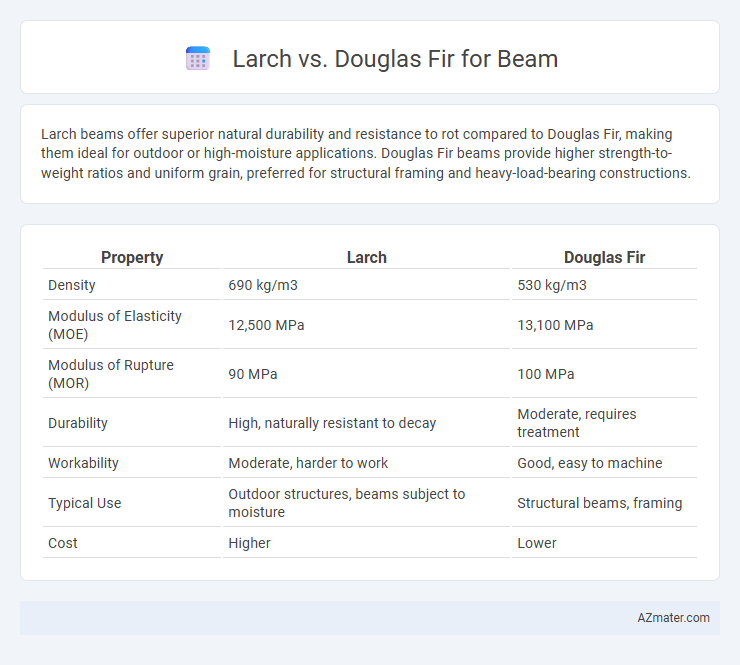Larch beams offer superior natural durability and resistance to rot compared to Douglas Fir, making them ideal for outdoor or high-moisture applications. Douglas Fir beams provide higher strength-to-weight ratios and uniform grain, preferred for structural framing and heavy-load-bearing constructions.
Table of Comparison
| Property | Larch | Douglas Fir |
|---|---|---|
| Density | 690 kg/m3 | 530 kg/m3 |
| Modulus of Elasticity (MOE) | 12,500 MPa | 13,100 MPa |
| Modulus of Rupture (MOR) | 90 MPa | 100 MPa |
| Durability | High, naturally resistant to decay | Moderate, requires treatment |
| Workability | Moderate, harder to work | Good, easy to machine |
| Typical Use | Outdoor structures, beams subject to moisture | Structural beams, framing |
| Cost | Higher | Lower |
Introduction: Larch vs Douglas Fir for Beams
Larch and Douglas Fir are popular choices for structural beams due to their strength and durability. Larch offers excellent resistance to decay and a high density, making it suitable for outdoor and exposed applications. Douglas Fir is renowned for its superior strength-to-weight ratio and consistent grain, providing reliable support in both residential and commercial construction.
Botanical Overview: Larch and Douglas Fir
Larch (genus Larix) is a deciduous conifer known for its needle-like leaves that turn yellow and fall off in autumn, primarily growing in cooler temperate regions of the Northern Hemisphere. Douglas Fir (Pseudotsuga menziesii) is an evergreen conifer native to western North America, distinguished by its thick, furrowed bark and flattened needles. Both species are valued in construction, with Larch prized for its natural durability and Douglas Fir for its high strength-to-weight ratio.
Strength and Structural Properties
Larch exhibits high density and excellent natural durability, making it a strong choice for structural beams with superior resistance to bending and compression compared to many softwoods. Douglas Fir is renowned for its outstanding strength-to-weight ratio, exceptional stiffness, and uniform grain, which provides reliable load-bearing capacity and dimensional stability in construction. Both species offer excellent mechanical properties, but Douglas Fir is often preferred for heavy structural applications due to its higher modulus of elasticity and predictable performance under stress.
Durability and Resistance to Decay
Larch wood offers exceptional durability and natural resistance to decay due to its high resin content, making it ideal for outdoor beams exposed to moisture. Douglas Fir, while strong and widely used structurally, has moderate decay resistance and generally requires chemical treatment to enhance its durability in humid environments. For long-lasting structural beams in exterior applications, larch outperforms Douglas Fir by providing superior resilience against fungi and insect damage.
Workability and Ease of Use
Larch offers moderate workability with good nailing and screwing properties, making it suitable for beam construction where durability is needed without excessive machining effort. Douglas Fir is highly valued for its excellent workability, featuring straight grain and uniform texture that allow for easy cutting, shaping, and fastening, ideal for beams requiring precision and structural reliability. Both woods perform well, but Douglas Fir tends to provide greater ease of use for complex joinery and detailed beam work.
Appearance and Grain Characteristics
Larch beams exhibit a warm reddish-brown hue with prominent, straight grain patterns that enhance rustic and natural aesthetics, making them ideal for visible structural elements. Douglas fir features a lighter yellowish-brown color with a tight, uniform grain and subtle growth rings, providing a clean, refined look favored in modern construction. Both species offer durability, but larch's pronounced grain texture creates a more textured visual appeal compared to the smoother, consistent grain of Douglas fir.
Cost Comparison and Availability
Larch beams generally cost less than Douglas Fir due to their wider availability in Europe and faster growth rates, making them an economical choice for construction projects. Douglas Fir, prized for its strength and durability, often commands a higher price and can be less readily available depending on the region, especially outside North America. The cost-effectiveness of Larch combined with its moderate availability makes it a competitive option compared to the premium pricing of Douglas Fir in beam applications.
Environmental Considerations
Larch beams offer excellent durability and natural resistance to decay, reducing the need for chemical treatments that can harm the environment. Douglas Fir, while strong and widely available, often requires more processing and treatment to achieve similar longevity, leading to higher environmental impact. Choosing sustainably sourced Larch or Douglas Fir certified by FSC ensures lower carbon footprints and promotes responsible forest management.
Best Applications for Each Wood
Larch beams excel in outdoor and moisture-prone environments due to their natural rot resistance and durability, making them ideal for decking, bridges, and exterior framing. Douglas Fir beams offer superior strength-to-weight ratio and dimensional stability, preferred for heavy structural applications like roof trusses, large-span beams, and timber framing in residential and commercial construction. Selecting between Larch and Douglas Fir depends on specific project requirements such as exposure conditions and load-bearing needs.
Conclusion: Which Is Better for Beams?
Larch provides excellent durability and natural resistance to decay, making it highly suitable for outdoor beams exposed to moisture. Douglas Fir offers superior strength and dimensional stability, ideal for structural beams requiring heavy load-bearing capacity. For beams in high-load indoor applications, Douglas Fir is generally better, while Larch excels in exterior, moisture-prone environments.

Infographic: Larch vs Douglas Fir for Beam
 azmater.com
azmater.com